Last Updated on November 7, 2024 by Owen McGab Enaohwo

Decisions. We all struggle with them, whether they are as insignificant as choosing what to wear or what to eat or as important as choosing what career to pursue.
The stakes are higher for business owners and managers. Revenue and share prices could tank if that PR mess isn’t handled promptly. Company culture may deteriorate if a dramatic employee isn’t disciplined. Productivity may grind to a screeching halt if bottlenecks are left unattended in a workflow.
But how are good decisions made? What factors should be considered before making a decision? Is there a decision-making framework that leads to better outcomes? In this article, we’ll explore decision making, what it is, the various types of business decisions, and how to make effective decisions quickly.
Learn how SweetProcess can help your team to be more productive and make better decisions without your input here.
What You’ll Learn In This Post
Why Businesses Make Bad Decisions
How to Make Better Business Decisions: 8 Steps
Other Factors That Influence Decision Making in a Business
Delegation: 6 Tips to Successfully Delegating Decision Making in Your Business
Your Employees Can Begin Making Better Decisions With SweetProcess!
What Is Decision Making?
Decision making is the process of choosing a course of action when presented with multiple courses of action. Much of decision making aims to do either of two things: to achieve a positive outcome or to avoid a negative outcome.
Everyone from the employees at the lower rung of the organizational hierarchy all the way to the top of the food chain will make decisions. Some decisions are low risk, while others are high risk. Naturally, you’d expect low-risk decisions to be made by those lower in the chain of command and vice versa.
This is why no one would trust something as big as a rebranding to an intern. At the same time, it would be ridiculous for a C-level executive to be overly involved with the grammatical exactness of a social media post.
Decisions, depending on the situation, may be time-sensitive or not. And one of the pressures of decision-making is quickly making the right choice. Other things that complicate decision-making include the maddening desire to get it right, ego, and a faulty or non-existent decision-making framework. Next, we’ll examine other pitfalls.
Why Businesses Make Bad Decisions

What is a bad decision? It’s easy to think about bad decisions as decisions with a negative outcome. But it’s not that simple. In a business context where you cannot predict all the outcomes of your choices, negative outcomes would be a poor way to qualify decisions.
It is much more sensible to qualify decisions on something more predictable, namely a decision-making framework. Nowhere is this more apparent than in the financial markets. All traders lose money. If a trader makes a good judgment call (based on research and logic), and the market goes against him, it’s not sensible to qualify his prediction as bad simply because the market moved unpredictably.
Rather, he uses a set of rules, a framework comprising trading and money management tactics to keep him profitable even if some outcomes prove unfortunate.
Some factors, however, negatively influence the decision-making process, leading to bad decisions. You need to be aware of them to avoid these pitfalls in the future when you need to make important decisions.
Paradox of Choice
One would imagine that a plethora of options would make it easier to make a choice, and quickly, too. But the reverse is the case. When presented with a variety of options, decision paralysis is often the result.
The concept of “paradox of choice” originated from a study in 2000 by a professor from the University of Colombia, who was trying to explore the increased difficulty accompanying the plethora of choices made available to consumers.
For the first test, they set up a stand in a busy mall where customers could taste a selection of 24 jams for free. Sixty percent of customers flocked to this stand. However, the variety proved to be overwhelming, and only 3% made a purchase.
For the second test, they set up a stand with only six jam samples. Naturally, this wasn’t as seductive as a 24-jam selection, so only 40% of customers took a taste test. But because it was easier to make up their mind, a whopping 30% of those who stopped by made a purchase, compared to the underwhelming 3% who stopped by the first stand.
Managers don’t shop for jams. But shopping for software in any category is enough to make anyone go white with paralysis. There are overwhelming options to choose from in any software category. But if you have a decision making process, you can more easily predetermine filters that limit your choices to a few options.
SweetProcess is a versatile tool that allows you to create assets that you can interlink and then share. Sign up for a free trial to learn more.
Perfectionism
The urge to get it right is one reason business leaders sometimes delay making time-sensitive decisions.
There are many types of decision makers. But regarding perfectionism, there are two types: maximizers and satisficers (dubbed so by the professor who conducted the jam study). The maximizers are concerned with making the best possible choice, while the satisficers merely concern themselves with making a good enough choice.
The former is prone to perfectionism and, therefore, the affliction of decision paralysis. But good decision-making isn’t reliant upon long timeframes. All that matters is having a good decision-making process.
A Suboptimal or Non-Existent Decision-Making Process
Not having a process to make decisions is a hearty invitation to decision paralysis and procrastination. But having an inefficient decision-making process isn’t any better, either.
An efficient decision-making process is a way for you to semi-automate decision making. This way, when you have to make any decision, you can use this system to make the best decision.
Not Enough Information

Because decision making involves choosing among many options to achieve an outcome, it’s important to understand the situation thoroughly.
Sometimes, decision makers make suboptimal decisions because they lack enough information. This means they don’t understand the problem thoroughly enough, or, even worse, they don’t understand the available courses of action.
For instance, a new graphic designer on a content marketing team has to design a case study. But this is a type of project the team hasn’t done before. If she doesn’t try to understand the existing design/branding approach, her design could be inconsistent with what existing customers are used to.
The more relevant information available, the better the decision quality.
How to Make Better Business Decisions: 8 Steps

Although most decisions are made to achieve positive outcomes and avoid negative outcomes, sometimes one can only make the best choice and be satisfied, regardless of the outcome.
In competitions of most kinds, athletes (competitors) make thousands of decisions: what to eat, what to wear, how to train, and when to eat to win a prize.
But no one can accurately predict who the winner will be. However, all the athletes try to make good decisions with their training, nutrition, and recovery. Sometimes, in business, you make the best decision based on the timing and the situation and go to bed happy.
If you cannot define the effectiveness of a decision purely by outcome, then it makes sense to create a framework (or system) within which you can make sound decisions.
In this section, we’ll explore a decision-making framework you can use to make sound decisions every single time.
Identify and Understand the Problem

This is the first step, where all good (and bad) decisions are made. To make any sound decision, you first have to be able to point to the problem with conviction.
A lack of conviction implies that you don’t yet understand the problem—not fully, at least. To understand the problem, you have to examine it from all angles. If it’s a problem your customers are having, put yourself in their shoes. If your employees complain about something regularly, try to understand the “why.”
Sometimes your imagination isn’t enough to understand a problem. During your consideration of the problem, you can ask questions. Ask your team. Talk to your customers. Try to decipher whether what you want to tackle is the main issue or simply a symptom of a more serious issue.
Take time to understand whether the decision you want to take can be tackled in isolation or whether other interrelated factors are involved.
You must thoroughly understand the problem you’re trying to solve. If you misdiagnose, you will misprescribe, and that could be disastrous.
Establish the Desired Outcome
Once you have a firm grasp of the problem, the next step is to decide where you want to go.
Consider how the outcome you’re aiming for will affect your team. Consider how it may change the course of your company or how it may impact the quality of your product or service. Think about who you might make unhappy with the decision and whether or not it’s worth it.
Remember that you cannot influence the outcome of some decisions. This means you’re going to have to measure success by other metrics.
Choose a Decision-Making System/Tool
Map in hand, destination in sight, now it’s time to choose a vehicle. How will you make a decision?
There are many tools to use to make a choice, but many are too complex to use. You can simply make a list of pros and cons, or you can decide to evaluate based on opportunity cost.
You can choose to use a decision matrix analysis, Ishikawa diagram, SWOT analysis, or any other method that best suits your situation. Keep in mind that not all decisions are complex and require complicated systems. Some decisions only need a simple pros and cons list.
Identify Suitable Alternatives/Possible Outcomes
There are many possible choices you can make and, consequently, many possible outcomes you may have.
While you’re trying to understand the problem and asking questions, no doubt the possibility of some outcomes will come to mind. Outline the ones that immediately come to mind, and then consider some more alternatives.
Laying out multiple choices and guessing the probable outcomes will increase your chances of making an informed decision, as you’ll have considered the issue from different angles and have anticipated all the obstacles and challenges you may face with each choice.
Choose Among Alternatives

Now, after examining the problem from different angles, it’s time to make a choice.
Suppose you’ve applied yourself to understanding the problem. In that case, you can make a decision with confidence, knowing that you have gathered enough information about the problem and are making a choice out of many choices.
Choosing confidently is important to help you live with the outcome of your decision.
Evaluate the Decision Based on the Criteria or Tools
Think of this step as a double-check.
You already have a desired outcome in mind, metrics to measure success and a decision-making process.
Now, lay your decision against all three and determine whether or not it fits. If it does, take action; if it doesn’t, go back to look at the alternatives and see if you can pick one that does.
Take Action
You’ve done all the work. Now it’s time for action.
Again, it’s important to take action with confidence. If you don’t have confidence in your decision and can’t defend it, review it until you do!
Review Your Decision
Here, you’re only looking to see how well you did.
Honestly, ask yourself the following: Did you follow your plan to the letter? Did you decide with enough information? Did you use an appropriate decision-making tool/criteria for success? Did your outcome meet all your criteria for success? What can you learn from that decision?
It’s important to take all the lessons from this decision so you can observe what works, what doesn’t, and what you can improve.
Other Factors That Influence Decision Making in a Business

Understanding the factors that influence decision-making can help you avoid (or lean into) those tendencies depending on the situation.
If, for instance, you needed to decide whose outcome directly affected emotions (like a branding decision), you’d do well to lean into emotional biases with copy and design.
But if your outcome was a maximal profit move, emotional biases may detract from that outcome. While this is an overly simplified example, it illustrates why it’s critical to understand the limiting factors and tendencies that affect decision making.
Psychology
It is needlessly arrogant for one to claim 100% rationality in decision making. Instead, it is helpful to understand one’s emotional tendencies and then make decisions in light of them.
One CEO may care greatly about whether their decisions make them look bad. Another may simply not care whatsoever how the team perceives them. If the former CEO isn’t aware of their tendencies, they’ll subconsciously make decisions that gain the favor of shareholders and their team. The same goes for other CEOs.
Emotional biases comprise many things, including personal values, personality, character traits, cognitive biases, habits, etc. It is important to know what these biases are.
Urgency

If a decision needs to be made quickly, it’s easier to make a mistake in panic. However, one of the things that can protect you from the influence of urgency is a solid decision-making process.
This way, whether you have to decide in five minutes or five hours, you’ll make a good one. It’s like having a versatile capsule wardrobe: any items you pick will pair well.
Risk and Reward
Sometimes, the outcomes of decisions aren’t binary. In some cases, it’s a question of how much will be gained and how much will be lost.
When making decisions, how or what you choose can sometimes depend on the risk-to-reward ratio of the outcome.
Information Accuracy/Completeness
This is probably the most important factor that influences decision making.
If your understanding of the problem is incomplete (or, worse, inaccurate), you stand to make colossal mistakes. This is why being well-informed is the first thing to do when making an important decision.
Ask your team for help, consult with more experienced people, or maybe even do your own research. If you miscalculate, you may end up a mile away from your actual destination.
Past Experiences
These can adversely (or positively) impact your decision making. Previous experience, if relevant, is an advantage. If irrelevant (or contradictory) to the current situation, it can cause you to make judgment calls that detract from your outcomes.
It’s important to be aware of past experiences and how they may affect your decision making in the present.
Objectives
One other thing that affects decision making is the objective or desired outcome since you have to decide the outcome you want from the onset.
Effective decision making cannot happen without first establishing the objective of the decision.
Not only do objectives inform the criteria that you use to make those decisions, but they also make it easier because they reduce the number of options/alternatives you have to choose from.
Priorities
Closely related to objectives are priorities.
Suppose an agency owner decides that their priority is quality service. When renewing contracts, it will be easier to release a client they cannot get results for or a client who constantly interferes with or micromanages their processes.
When setting out objectives, priorities will usually sort themselves out.
Types of Business Decisions

Because a business is made up of many moving parts, there are a myriad of decisions to be made daily. It is helpful to know (broadly) the main areas of business decisions so you can begin to understand how you’ll apply the decision-making process we’ll discuss shortly.
Although you’ll typically make many decisions, the following are the main categories of decisions frequently made in a business.
Strategic
Of all the decisions you will make, this is the most important. Strategic decisions should strictly be made by upper-level management.
Strategic decisions are those that tie directly with achieving business objectives. If, for instance, the goal of a fashion company is to be sustainable, strategic decisions may tackle how they could still produce clothes that leave room for good profit margins.
Strategic decisions also determine a company’s direction. If a market or the economy changes, a company must pivot to accommodate those changes. If strategic decisions aren’t thought out, a company can go bust.
Imagine investing millions into R&D for a new product, and the product doesn’t catch on. Sorrow, sorrows, prayers. Something else to remember: business structure and policy decisions fall under strategic decisions because they help create an organizational culture.
Operational
Although strategic decisions affect every ramification of a business, operational decisions are a bit different.
Operational decisions guide the day-to-day running of the business. They include marketing campaigns, account audits, customer service–related decisions, and inventory management.
Routine is the hallmark of operational decisions. Although they are routine, they aren’t less important. Clogged, inefficient workflows can quickly become a nightmare. This is why creating processes and procedures is important to keep things running smoothly.
A company’s products/services are only as good as the systems that create them. You can create these systems with SweetProcess. Click here to learn more.
Hiring
Good systems aren’t worth much if competent employees don’t execute the processes and procedures within the system.
Your team members should be easy to work with, receptive to feedback, and have a sense of accountability.
Hiring decisions usually involve writing attractive job descriptions to attract top talent, choosing suitable candidates, deciding on the interview style to use, and determining the required qualifications and skills.
Hire slow, fire fast.
Financial
This is another type of business decision you must invest in.
Money makes things happen. If there’s enough, things get done. If not, you and your team may be embroiled in an eternal game of scrimping and scrambling to execute simple tasks.
Sure, resourcefulness is fun. However, operating from a place of abundance will keep a business running for many years, so it’s important to make excellent financial decisions.
Product pricing, budget decisions, manufacturing costs, strategies to reduce overhead, payroll management, and debt repayment are some of the routine financial decisions you’ll make.
Technology
We live and do business in a world ruled by technology.
Sometimes, you will be faced with choosing what software your team will use, whether or not it’s time for an upgrade, or whether you should renew your subscription.
You’ll need to make decisions on HR software, accounting software, communication software, and databases from time to time.
Delegation: 6 Tips to Successfully Delegating Decision Making in Your Business
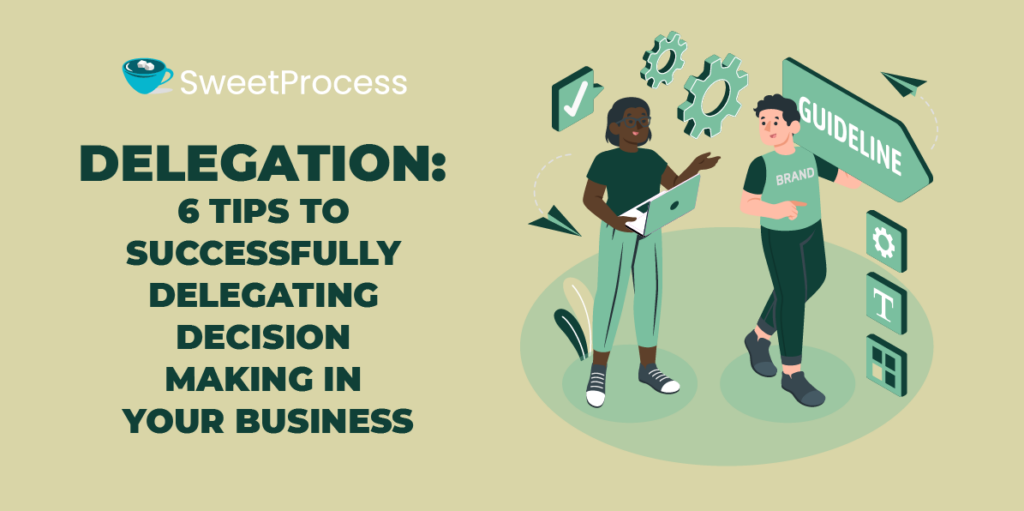
Having a strong decision-making framework is ideal, but you won’t be the one making decisions in your company all the time. Every business comprises small units (people) that are always making decisions. The quality of that business’s product/service ties directly to the quality of the decisions of others.
Team members making good decisions isn’t a matter of luck, however. You can do some things to help your team make better decisions.
In 2002, IBM realized that the market was changing, and they needed to pivot from selling just hardware to investing more in providing better services for their customers. In a move dubbed “ValuesJam,” employees were required to affirm IBM values. IBM CEO Sam Palmisano aimed to unify the company’s culture and bring everyone on the same page so they could deliver better services.
Now that they were focusing on services, employees would operate without much supervision and were the brand’s penultimate representative. Sam wanted his employees to make better decisions that aligned with IBM’s core values without supervision.
One problem in particular was that lower-level managers were delaying getting approval for minor expenses. This was getting in the way of IBM’s “dedication to every client’s success.” In response to this, all of IBM’s 22,000 frontline managers were given $5,000 of discretionary funds that they could use to provide better (and faster) services for their clients. Sam called this the “$100 million bet on trust.”
Apart from propagating a strong culture or empowering your team (like Sam did), you can do a myriad of things to help your team make strategic decisions every day. We’ll explore some of these presently.
Cultivate Your Organizational Culture
Nothing makes for efficient delegation more than a strong culture that everyone understands and connects with. A strong culture will ensure that everyone on your team is weighing every decision against the framework of your company’s goals, objectives, or vision.
This is the influence that corrects problems before they even begin. Whenever anyone on your team faces a problem that the books don’t outline, they can make good decisions if they understand the overall strategy and vision of the company.
Sam Palmisano understood the power of a strong, vibrant culture and used it to ride the pivotal tide in IBM.
Define Roles And Responsibilities
It is unrealistic to dump responsibilities onto employees’ laps and expect them to make good decisions automatically.
When you delegate decision-making, you will have to define who has what level of authority and what things they can or cannot do. This provides your team with clarity and prevents clashes, as everyone knows what tasks have been assigned to them.
When defining roles for your team members, also make sure to outline what their responsibilities are. This way, you can encourage accountability and measure performance. It also helps to establish what the desired outcomes are.
Invest in Employee Training and Coaching
If your team is well educated, this will reflect in the quality of your products/service.
You can pay for courses or mentorship. Look for professionals with specialized knowledge to coach your team. You’ll get value for your money because whenever decisions need to be made, they’ll make them with the insights of an expert.
If your sales team works with an industry veteran, they’ll begin to approach sales with some more nuance because they know now that they might have had to figure it out over time.
Document Your Company’s Processes

Even though this isn’t as important as some of the tips we’ve mentioned so far (in the context of making decisions autonomously), it is still relevant to the discussion because organizational process assets help to provide content to whoever is handling tasks.
Do you remember how we talked about defining roles, responsibilities, and outcomes/expectations? Processes, policies, and procedures help to establish those.
Even better, if you have them documented, that is autonomy on steroids. Jane could have been eaten by a tiger on the way to work, but Joan could have taken over and handled Jane’s tasks because there’s a clear path from start to finish, with responsibilities and outcomes clearly defined.
Resist the Urge to Micromanage
If you’re a perfectionist, we’re sure you can relate to the fear of things not being done up to a standard you’re satisfied with.
The trick to getting others to do work you approve of is giving them your framework(s), the way you think about problems, how you typically solve them, and what outcomes you expect. If you also provide them with pointers to assess their performance, they’ll be more likely to self-criticize and make adjustments as needed.
For a graphics designer, this looks like understanding the company’s vision and mission and then following a brand style guide.
To be honest, if you have processes in place, if you invest in employee education, and if your company culture/vision/mission is clear and your team synchronizes with those, you’ll be able to relinquish more and more control.
Why? Because they’re on the same page as you are, and you’ll have given them all the tools they need to make sound decisions.
Be Patient and Allow for Failure
You may find this to be sentimental, but it’s important to give your team room to make mistakes. This is the only way they can become like you and make better judgment calls.
Decision making is a skill; like every other skill, it takes time to hone.
Create a safe space for your team to do their best work. And if they do fall short, provide constructive feedback that they can use to make better decisions in the future.
A Tale of Two Companies: How a Podcast Agency and a Law Group Simplified Decision Making With SweetProcess

Two businesses. One problem.
Although very different and offering different services, Rise25, a podcasting service, and Brooks Law Group had the same problem: a choppy decision-making system.
In both scenarios, employees were limited by inefficient systems and always had to rely on their CEOs for input in their decisions. In the case of Brooks Law Group, employees made mistakes as they repeatedly made poor choices.
Jeremy, Co-founder of Rise25, recognized that their processes weren’t consolidated and organized. This meant that his team members were always bothering him with trivial issues.
Things got so bad that Jeremy had enough. He knew he had to do something to ensure his employees could complete their tasks and make decisions without his input. He needed some level of autonomy so he could focus on more important things.
He found SweetProcess, and within a week of deploying it, the demand for his time began to dwindle because his team could now find what they needed to make low-level decisions without his input. Using SweetProcess made it easier to delegate decision making because now, anyone on the team could be shown what to do and how to do it.
For Brooke Law Group, the problem was similar. Although they had processes, Laura, who was in charge of admin/HR at the firm, observed that their existing system wasn’t easy to use and accessible. This meant that her team sometimes made grievous mistakes, and productivity slowed down.
By some stroke of luck, she found SweetProcess, and all the team had to do was import all their processes from their internal solution. She then assigned someone on the team to organize all the named processes and procedures into folders to easily be perused and shared.
SweetProcess freed Laura because her employees no longer needed her. They now had processes they could refer to when they had questions. This meant they could make decisions even in her absence, and the business wouldn’t fall apart regardless of who was absent or unavailable.
Simplify Decision Making With SweetProcess
SweetProcess is mainly a process documentation software.
But you can use it to improve certain decisions in your business. For instance, processes can help your team make routine decisions easily without mistakes. Every step is laid out from start to finish.
With the task manager in SweetProcess, you can also delegate specific steps in processes as tasks and monitor their progress.
How to Use SweetProcess to Create Processes
Using SweetProcess, here’s a simple process for onboarding clients.
Step 1
On the dashboard of your SweetProcess account, locate the “Processes” option on the far left of your screen.
Beside it, there’s a plus sign.
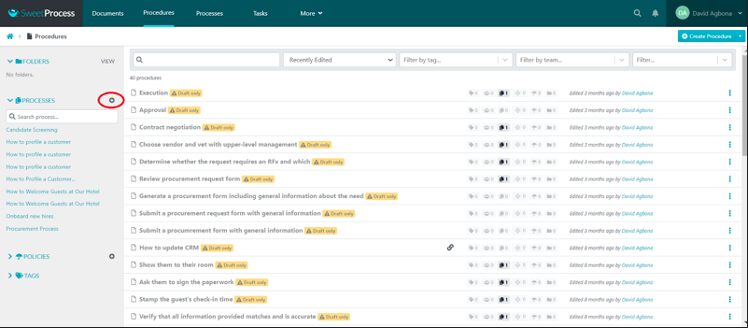
Step 2
Once there, give your process a title. This is so you can stay organized.
Type in your title and click “Continue.”

Step 3
After titling your process, add the steps that make up the process by clicking “Add Step.”
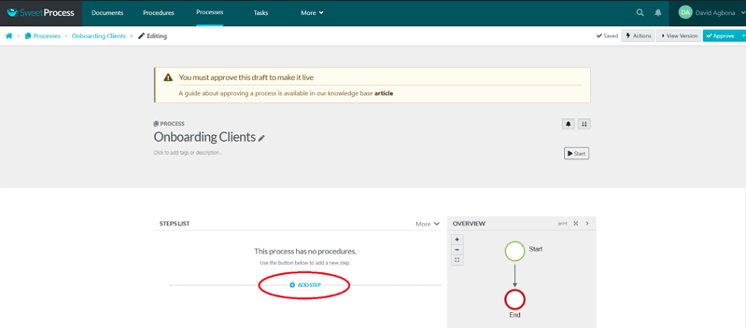
Step 4
When you click “Add step,” you’ll be presented with a menu.
From that menu, choose “Procedure.”
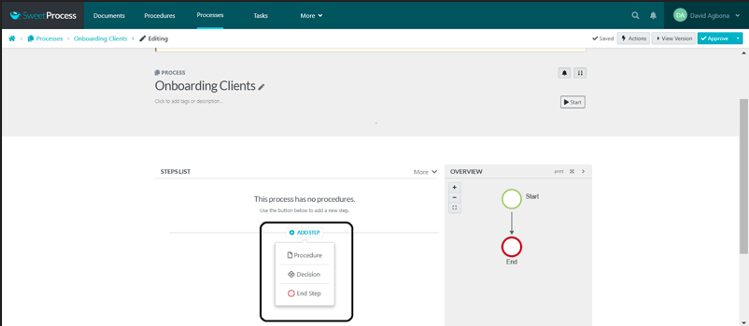
Step 5
A dialog box will appear, allowing you to title that step.
Title it and press “Enter.”
You have created your step.
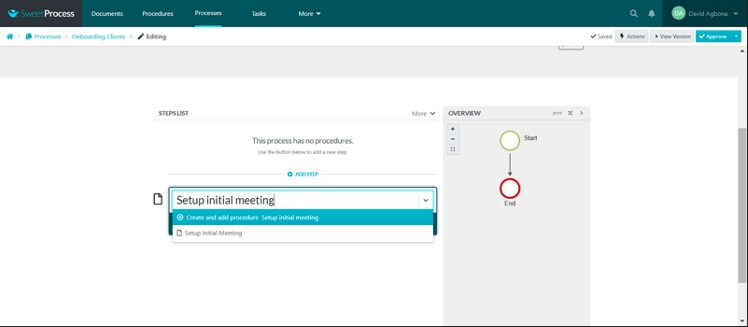
Step 6
Repeat this until you have added all the steps.
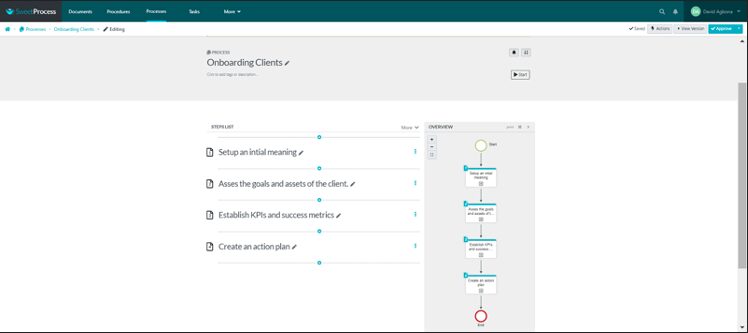
Step 7
Processes will remain drafts until you approve them. Otherwise, they cannot be shared and viewed.
Depending on your position on the team, you can either “Approve and Notify,” “Approve & Request Sign-Off,” or “Request Approval.”
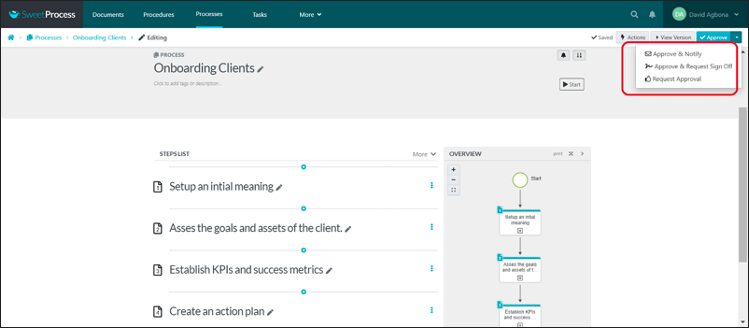
How to Use SweetProcess to Delegate Tasks

Not only can you create processes with SweetProcess, but you can also assign those processes or steps within those processes to specific team members. Even better, you can monitor their progress and set deadlines.
Here’s how to do that in a few short steps.
Step 1
Go to tasks in the top menu of your dashboard.
Once there, click on “Assign Task” in the top right corner.

Step 2
Once you click “Assign Task,” a dropdown menu will appear. From there, you can choose from any of the steps you have created in the past.
The options you have are listed in alphabetical order. But if you can’t easily find what you’re looking for, or your dropdown menu is a mile long, you can easily look up the task you need in the search bar.
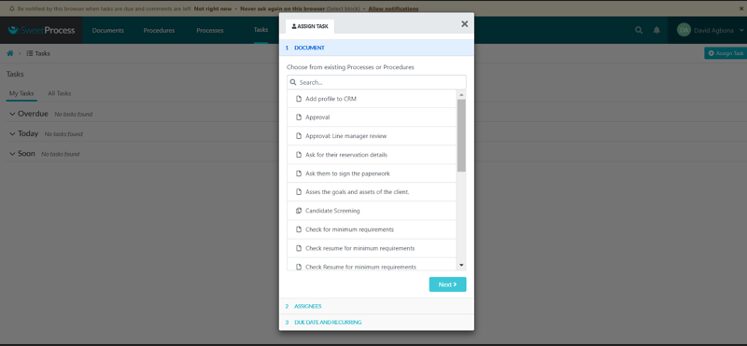
Following our onboarding example, search for the word “meeting” to bring up the step so we can assign it.
Type in the search bar and the step comes up.
Once it does, click “Next.”

Step 3
In the dialog box that appears, “Assign to Teammate,” type in the name of your team member(s) to assign the task.
You can assign the task to your team members as a whole, or you can assign them the tasks individually. You can choose either option from the “Assign” box.
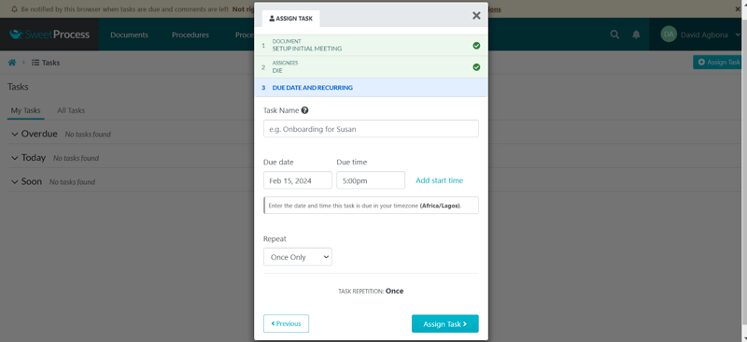
Step 4
In the third field that appears, you can then set timelines and deadlines for the task as you deem appropriate.
You can set how frequently you want the task to be repeated.
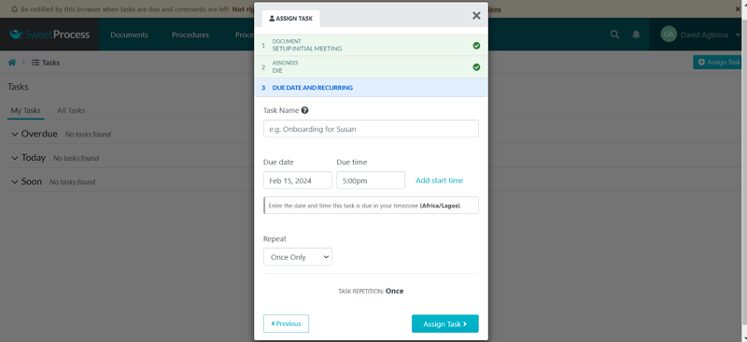
Step 5
And just like that, you can monitor the task and their progress!

How to Use SweetProcess to Create Policies

Policies are strategic decisions that build organizational culture. Creating policies with SweetProcess will help you cultivate a culture, and a conducive environment that makes it easy to achieve your goals.
Step 1
On the dashboard of your SweetProcess account, find the word processes.
Beside it, there’s a plus sign.
Step 2
On your SweetProcess dashboard, you can navigate to “Policies” in one of two ways.
Either you click “More” in the dropdown menu at the top of your dashboard, or you click on the side panel and click the plus button beside “Policies.”
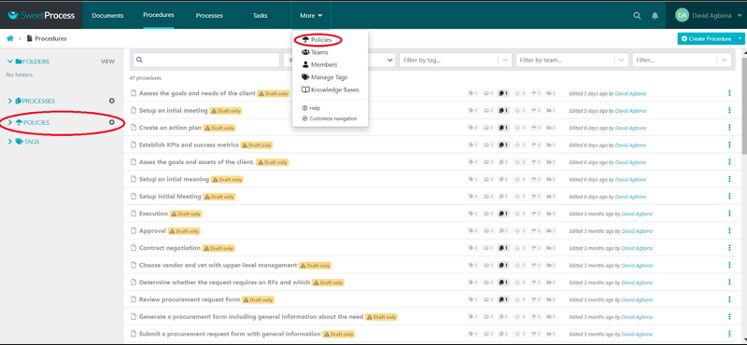
Step 3
In the dialog box labeled “Policy Title,” name your policy so you can keep track of all your edits as you progress.
Then click “Continue.”
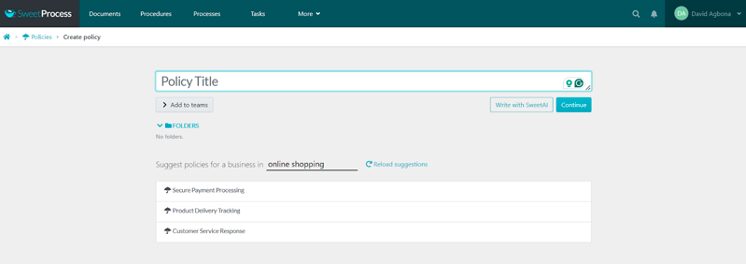
Step 4
You will be presented with a dialog box that allows you to use SweetAI, our proprietary AI, to write the policy.
But for this demonstration, and in case you would rather write the policy yourself, press “Click here to edit policy content.”
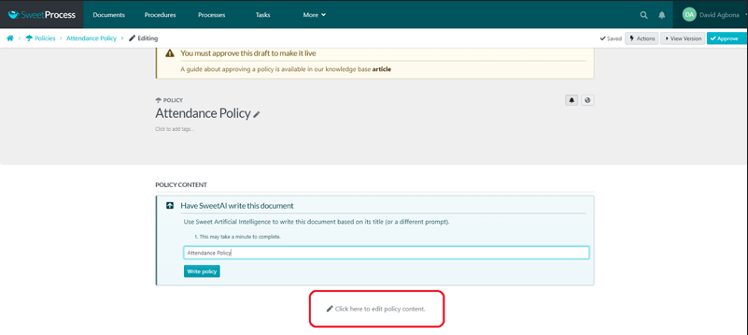
Step 5
Type your policy in the text editor.
Click “Save Changes.”
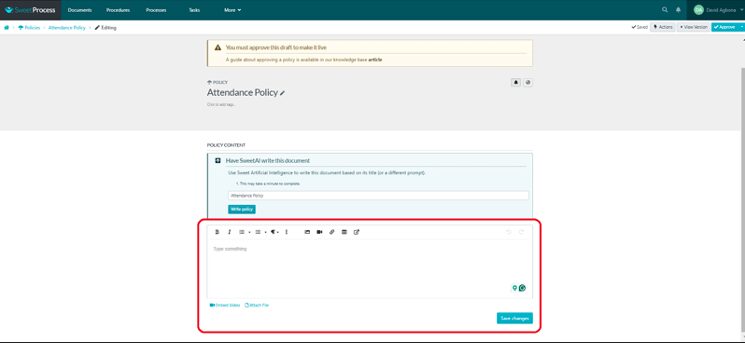
Step 6
Once you do that, all that is left to do is to approve your policy.
To do this, navigate to the upper right corner of the screen and, depending on your role in the team, approve the policy or request approval.
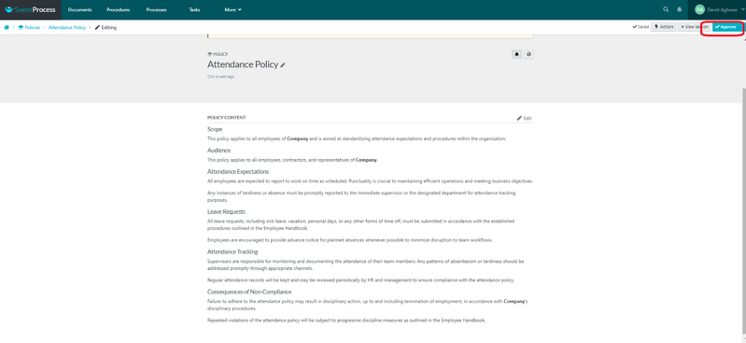
And voila! Your policy is ready to be shared and added to your knowledge base.
How to Use SweetProcess to Create Procedures
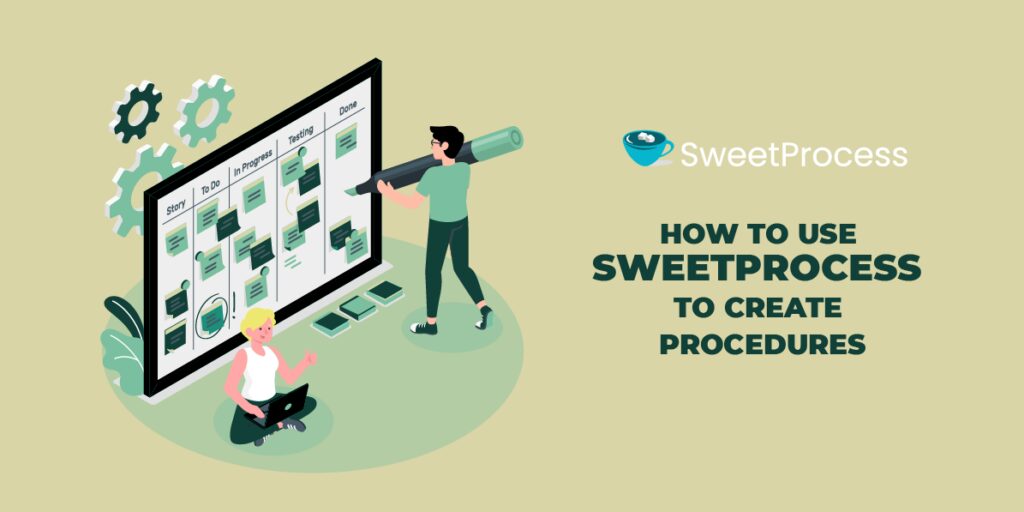
Procedures are more detailed than processes, and they can help your team to make better choices, too.
Here’s how to create them.
Step 1
Navigate to the top menu of your dashboard.
Once there, click on “Procedures.”

Step 2
Navigate to the top right corner and click “Create Procedure.”

Step 3
In the dialog box that appears, title your procedure so you can stay organized.

Step 4
Although you can create procedures similar to how you would create processes, you can also use SweetAI to create procedures from scratch and then edit the output.
To do that, simply press “Write with SweetAI.”

Step 5
And you have your procedure, easy peasy, complete with a process map.
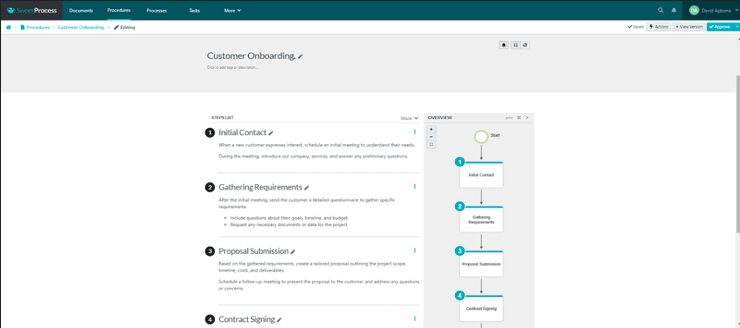
All that’s left to do is to approve your procedure.
To do that, navigate to the top right corner and then click “Approve.”
Once you do that, you’ll be able to share your procedure with your teammates.
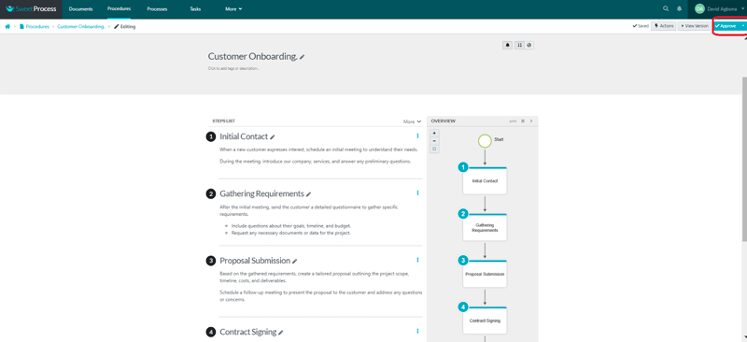
Your Employees Can Begin Making Better Decisions With SweetProcess!
The quality of business decisions will determine how long you stay in business, affecting the quality of your products and services.
Making good decisions as often as possible is crucial because business is much like a snowball rushing down a mountainside. Good decisions stack and lead to massive wins. Bad decisions also stack up and can lead to horrific losses.
Give your team the tools they need to make better decisions today.
Check out how SweetProcess works here.

